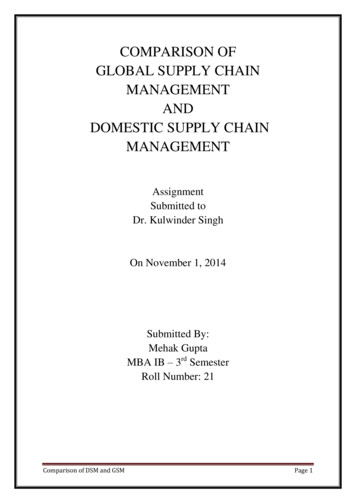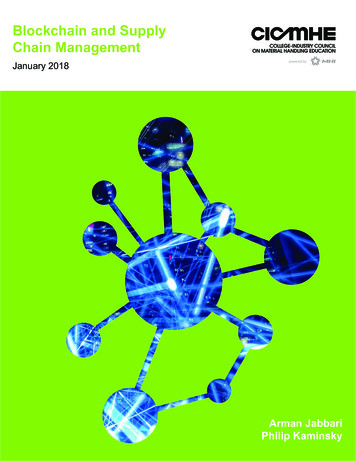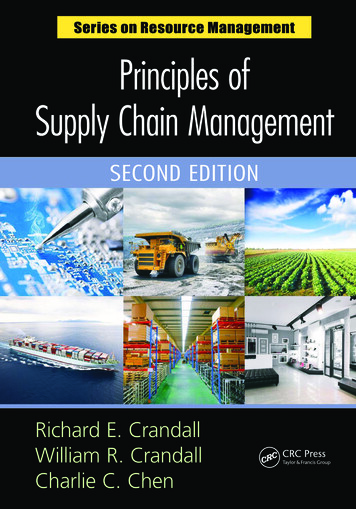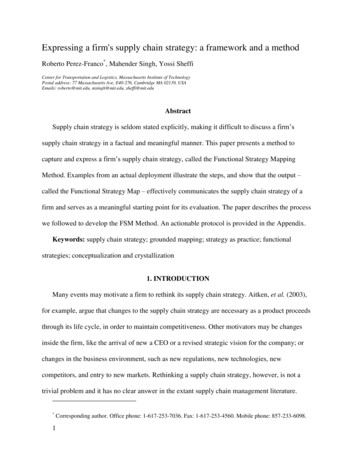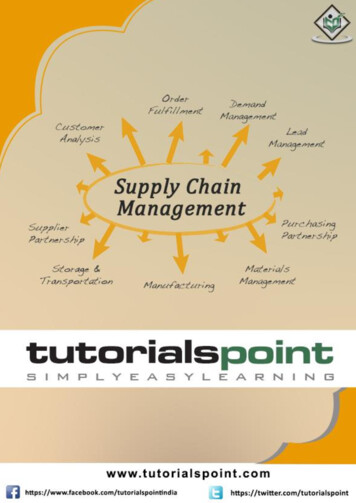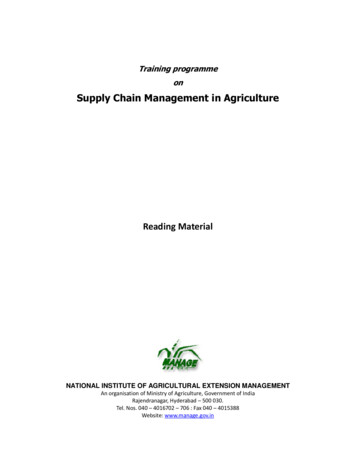
Transcription
Training programmeonSupply Chain Management in AgricultureReading MaterialNATIONAL INSTITUTE OF AGRICULTURAL EXTENSION MANAGEMENTAn organisation of Ministry of Agriculture, Government of IndiaRajendranagar, Hyderabad – 500 030.Tel. Nos. 040 – 4016702 – 706 : Fax 040 – 4015388Website: www.manage.gov.in
CONTENT1.Integrated Agri-supply chain management03-172. Agricultural marketing scenario in India18-233. Supply Chain Management in Horticulture24-404. Supply Chain Management in dairy41-405. Supply Chain Management in Poultry41- 452
CHAPTER - 1Integrated Agri-supply chain managementSupply chains are principally concerned with the flow of products and informationbetween supply chain member organizations—procurement of materials, transformation ofmaterials into finished products, and distribution of those products to end customers. Today’sinformation-driven, integrated supply chains are enabling organizations to reduce inventoryand costs, add product value, extend resources, accelerate time to market, and retaincustomers.The real measure of supply chain success is how well activities coordinate across thesupply chain to create value for consumers, while increasing the profitability of every link inthe supply chain. In other words, supply chain management is the integrated process ofproducing value for the end user or ultimate consumer.The supply chains of different agricultural commodities in India, however, are fraughtwith challenges stemming from the inherent problems of the agriculture sector. The agrisupply chain system of the country is determined by different sartorial issues like dominanceof small/ marginal farmers, fragmented supply chains, absence of scale economies, low levelof processing/value addition, inadequacy of marketing infrastructure etc.Early processing-based supply chain management success included improvedrelationships between warehousing and transportation within companies as a result ofreduced inventory and better response time to customer requests for products and services.Supply chain management then entered a logistics stage where other functional areas withincompanies joined forces to incorporate manufacturing, procurement, transportation,distribution, and marketing to effectively compete in the marketplace. This stage was aidedby the use of telecommunications, electronic data interface, and other technological advancesthat made the transfer of information more transparent across the functional areas betweencompanies.3
1.1 Food supply chain NetworksA processing-based and organised agri-supply chain functions as a part of a verycomplex network. Figure 1 depicts a generic supply chain at the organization level within thecontext of a complete supply-chain network. Each firm is positioned in a network layer andbelongs to at least one supply chain, i.e. it usually has multiple (varying) suppliers andcustomers at the same time and over time.Fig- 1: Schematic Diagram of Supply Chain1.2 The advantages for supply chain membersIndividual suppliers, producers and marketers who are associated through a supplychain coordinate their value creating activities with one another and, in the process, creategreater value than they can, when they operate independently. Supply chains create synergiesin one of three ways:i)They expand traditional markets beyond their original boundaries and thus increasesales volume for members;ii)They reduce the delivered cost of products below the cost of competing chains and thusincrease the gross margin for the working capital committed by members of the chain ;andiii)They target specific market segments with specific products and they differentiate theservice, product quality or brand reputation of the products they deliver to these market4
segments and thus increase consumer perception of delivered value. In this way, theyallow chain members to charge higher prices.Generally, supply chains increase market contestability both at the producer end and atthe consumer ends of the chain. At the consumer end, chains compete primarily throughprice, differentiated products and services and differentiated terms of sale. At the producerend of the chain, supply chains compete with one another primarily for "producer affiliation"and core vendor commitments.1.3 Components of an Agri supply chainAgribusiness, supply chain management (SCM) implies managing the relationshipsbetween the businesses responsible for the efficient production and supply of products fromthe farm level to the consumers to meet consumers’ requirements reliably in terms ofquantity, quality and price. In practice, this often includes the management of both horizontaland vertical alliances and the relationships and processes between firms .Agri-supply chains are economic systems which distribute benefits and apportionrisks among participants. Thus, supply chains enforce internal mechanisms and develop chainwide incentives for assuring the timely performance of production and deliverycommitments. They are linked and interconnected by virtue of shared information andreciprocal scheduling, product quality assurances and transaction volume commitments.Process linkages add value to agricultural products and require individual participants to coordinate their activities as a continuous improvement process. Costs incurred in one link inthe chain are determined in significant measure by actions taken or not taken at other links inthe chain. Extensive pre-planning and co-ordination are required up and down the entirechain to affect key control processes such as forecasting, purchase scheduling, production andprocessing programming, sales promotion, and new market and product launches etc.Following are the components of an organised agri- supply chain:1. Procurement or sourcing2. Logistic managementa. Transportationb. Material managementc. On the premise of supplying mostly from production not stock5
d. Warehousinge. Logistics Network modeling3. Organizational managementa. Contractingb. Strategic alliances and partnershipsc. Vertical integrationi. Long term storageii. Packaging technologyiii. Cold chain managementiv. Energy efficient transportv. Quality and safety4. Application of Efficient Consumer Response (ECR) Systema. Electronic scanning of price and product at the point of saleb. Streamline the entire distribution chain1.4 Agri marketing and emergence of coordinated supply chains in IndiaThe agri supply chains in India and their management are now evolving to respond tothe new marketing realities thrown by the wave of globalisation and other internal changeslike rise in the level of disposable income of consumers, change in the food basket of theconsumers towards high value products like fruits, vegetables and animal protein. The newchallenges of the agricultural economy of the country have now spurred the governmentagencies to go in for different legal reforms for enabling and inviting private investment inagricultural marketing infrastructure, removing different entry barriers to promotecoordinated supply chain and traceability.The amended APMR Act, the major agricultural Marketing Act of the country, beingimplemented by the different states of India, now contains enabling provisions to promotecontract farming, direct marketing and setting up of private markets (hitherto banned). Thesemeasures will go a long way towards providing economies of scale to the small firms inestablishing direct linkage between farmers, and processors/ exporters/ retailers, etc. Thus,the measure will provide both backward and forward linkages to evolve integrated supplychains for different agri produce in the country.6
1.5 Marketing channels:While studying the supply chain-management issues of the agriculture sector, it isworthwhile to analyse the prevalent market channels of some commodities to bring thediscussion to perspective.Marketing channels for fruits and vegetables in India vary considerably bycommodity and state, but they are generally very long and fragmented. Figure 4 presentstypical marketing channels for mangoes and onions in Tamil Nadu. The majority of domesticfruit and vegetable production is transacted through wholesale markets although dependingon the state and commodity; farmers may sell to traders directly at the farm gate, to traders atvillage markets, or directly to processors, co-ops and others. Some of the the commonproblems in agri supply chains in India are presented in Table-1 and Figure-2 describesmarketing channels of mango and onion, prevalent in Tamil Nadu.ProductionPoor extensionQuality inputsLow productivityDeficient andinefficient productionmanagement Non demand linkedproduction Improper post harvestmanagementresulting in poorqualityTable-1: Broken Links in Agri Supply Chain in IndiaSupply ChainProcessingMarketingLack of storage Low processing PoorinfrastructurePoor transportation Lack of quality Lack ofHigh wastages Poor returnsgradingMultiple intermediaries Low capacity No linkagesutilizationFresh produce transported to Nonmandis in open baskets ortransparency ingunny bags stacked one on toppricesof the other Long delays Cold chain absent or broken,from producerproduce deteriorates rapidlyto retailer Food safety is major concern:Hygiene and pesticide MRL notmonitoredEach segment working in an isolated manner resulting in multiple losses across the value chain Figure-2: Marketing ChannelsMarketing Channels for Mango in Tamil NaduMarketing Channels for Onions in Tamil NaduSource: Ramasamy, et al (2003)7
1.6 Coordinated supply chainsIn the last few years there has been an emergence of more coordinated supply chainsfor fruits and vegetables in India catering to the export market and to the high end domesticmarket. On the domestic front this trend has primarily been led by the growth of largehypermarkets, supermarkets and other organized retailers in metropolitan centers. Forexports, the emergence of dedicated export chains has been prompted by stricter quality andsafety standards in certain export markets.Coordinated supply chains involve structured relationships among producers, traders,processors, and buyers whereby detailed specifications are provided as to what and howmuch to produce, the time of delivery, quality and safety conditions, and price. Theserelationships often involve exchanges of information and sometimes assistance withtechnology and finance. Coordinated supply chains fit well with the logistical requirements ofmodern food markets, especially those for fresh and processed perishable foods. These chainscan be used for process control of safety and quality and are more effective and efficient thancontrol only at the end of the supply chain.Several companies in India are beginning to invest in integrated supply chainmanagement systems and infrastructure with emphasis on quality and, to a lesser extent, onsafety. Different models are emerging including fruit and vegetable retail outlets that directlyprocure produce from farmers or grower associations through various formal/informalcontractual arrangements. Collection-cum-grading centers have been established in ruralareas with all produce moving through a central distribution facility having moderninfrastructure including cold storage, ripening rooms and controlled atmosphere chambers.Growers are required to follow certain specifications and are often provided with some inputsand technical advice about agronomic and post-harvest practices.Contract farming for fruits and vegetables is already being practiced in several statesand is likely to expand considerably due to legal reforms initiated in India, i.e.,implementation of Model APMC Act. Until recently, contract farming was not legallyrecognized in most states and a legal framework for governing contracting arrangements wasmissing. Under the APMC Model Act a new chapter on ‘contract farming’ was added whichprovides for the registration of contract buyers, the recording of contract farming agreements,8
and time-bound dispute resolution mechanisms. It also provides an exemption from the levyof market fees for produce covered by contract farming agreements and provides indemnityto farmers’ land to safeguard against the loss of land in the event of a dispute. Contract buyerswill now be able to legally purchase commodities through individual purchase contracts orfrom farmers markets. Provision has also been made in the legislation for direct sale of farmproduce to contract buyers from farmers’ fields without it being routed through notifiedmarkets.A terminal market for fruits and vegetables has been set up in Bangalore. The market(known as SAFAL) can physically handle up to 1600 metric tons of produce a day. It islinked to some 250 Farmers Associations and 40 Collection Centers that have beenestablished in selected producing areas. The market receives sorted, graded and packagedproduce from these associations and centers and this is then auctioned at the market. SAFALalso has forward linkages to a number of retail outlets (Cash and Carry Stores). The markethas modern infrastructure, including temperature and humidity controlled storage facilities,and ripening chambers. This calls for the collective action in supply chains.Initiatives are taken to establish more terminal markets based on moderninfrastructure. MTMs would endeavour to integrate farm production with buyers by offeringmultiple choices to farmers for sale of produce such as electronic auctioning and facility fordirect sale to exporter, processor and retail chain network under a single roof. In addition, themarket would provide storage infrastructure thus offering the choice to trade at a future dateto the participants. It is envisaged to offer a one-stop-solution that provides Logistics supportincluding transport services & cool chain support and facility for storage (includingwarehouse, cold storage, ripening chamber, storage shed), facility for cleaning, grading,sorting, packaging and palletisation of produce and extension support and advisory tofarmers.The model presents integration of agri supply chains for perishables through MTMs.Presently in the regime of fragmented and inefficient agri supply chains there is no controland command of chain partners on the other following that they are not able to maintainquality of produce in their chain. In order to bring integrated command, source quality9
produce by way of organizing farmers in groups and providing them the right technicaladvice and link farmers to the market, modern terminal market complexes will prove a dent.Fig-3: Schematic Diagram of Terminal Market ConceptThe role of Collective Action (CA) in agri supply chain arises wherever there areeconomies of scale in production or in marketing. This includes the role of farmer groups inbeing better able to ensure traceability. In these chains, the costs for the establishment oftraceability are lower for firms and farms with collective action than without it. Similarly,collective action has a rationale if agents in the supply chain have different comparativeadvantages. Thus, a producer group (with comparative advantage in production) could benefitfrom collaboration with agents that have expertise in marketing.With increasing private investment in the food retail sector and impending changes incontract and marketing laws, shorter and more direct supply chains with traceability areexpected to become more common. The incidence and spread of coordinated supply chainswill be closely connected with the pace and direction of food retail sector modernizationwithin India. Thus far, changes in food retail have been gradual, and considerably slower thanobserved in many other developing countries.Supermarket procurement regimes for sourcing of fruits, vegetables, dairy and meatstrongly influence the organization of the supply chains. The rising scale of organized retail10
in the Asian countries (like Metro Cash & Carry, Tata Chemicals and Field Fresh Foods,Bharti Enterprises, Reliance Fresh in India) is now playing a vital role in organizing farmerproduction bases and integrating these into the retailers’ fresh produce supply chain, thusprocurement systems in this segment is changing fast responding to the consumer demandand competition.The Farm-to-fork modelRetail RouteMandi RouteFarmerFarmerAggregatorMarket YardCollection CentreWholesalerSub- WholesalerRetailerRetailerConsumerConsumerFig-4: Changing Supply Chain with Entry of Organized RetailingBesides the presence of retailers in the countryside for farm produce sourcing, nowthere are also some players; who are helping various retail chains for their sourcingrequirements. For instance, DCM Shriram Consolidated Ltd (DSCL) is in the process oftying up with them to source fruits and vegetables from farmers and supply to the retailchains. DSCL is already doing this for Future Group's Food Bazaar, south based Subhikshaand RPG's Spencer. The new tie-ups would help the company to operate on economies ofscale, and to operate all over the country.1.7 Case studies of integrated supply chain managementDifferent models of agri supply chain management have come up across the Asiancountries. The integration in the traditional disjointed supply chain has been made possiblethrough different revenue models developed by the organized retailers, exporters, processorsthrough contract farming, etc. The chapter contains some case studies on integrated supplychain in India and other Asian countries.11
Case Study-1: Mahagrapes:One of the largest exporters of fresh Grapes (mainly seedlessgrapes) from India.Mahagrapes is a partnership firm of sixteen grape growers cooperatives. In keepingwith the international trend of fruit growers becoming exporters, the vineyard owners ofMaharashtra entered the International market with their own brand, Mahagrapes. It acts asfacilitator, quality controller, input supplier as well as service provider to its membersocieties. The hard working grape growers in areas of Sangli, Solapur, Pune & Nasik regionsof Maharashtra have formed 16 co-operative societies with a membership of almost 2500farmers.Mahagrapes was born on 19th Jan 1991 with the valuable support of:1) National Co-operative. Development Corporation (NCDC), New Delhi.2) Government of Maharashtraa. Department of Co-operationb. Maharashtra State Agriculture Marketing Board, Pune.3) Agricultural & Processed Food Products Export Development Authority (APEDA), NewDelhi.4) National Horticulture Board (NHB), New Delhi.Objectives of Mahagrapes:1.Upliftment of farmers’ community.2.Growth of Co-operative Movement.3.Encourage and develop agricultural export.4.Maximize Foreign Exchange earnings.5.Update the farmers on the latest technology in farming6.Acceptance of global challenge with a commitment to qualityFunctions:1.To source and develop worldwide markets.2.To provide Quality control in post harvest activities.3.Provide extension services to members of co-ops for production of export qualitygrapes.4.Supply and supervise branded packaging.5.Provide logistical support12
6.Provide advance payment to farmers for their produce.7.Obtain best price for produce.8.Pass on the benefits to the Co-ops.To reach individual farmers was a difficult task to which formation of co-operativesocieties has provided the answer. Each co-operative society is equipped with a pre-cooling &cold store facility; the technology imported from California, which has proved to be anessential export tool. We provide societies with day-to-day international market price andsupply them with all the packaging materials required for exports.Fig-4 Mahagrapes Supply ChainWhy it is a success story? Exporting to European markets with almost nil rejection for past sixteen years. It is asuccessful business entity. It has shown acumen as well as agility. Mahagrapes has linked grape growers to international markets and has compressed thesupply chain. In doing so it has assumed barometric role. It is pioneer in bringing pre-cooling technology and array of post harvest operations. Allthese operations have pulled the farmers upwards in supply chain. It is a story of successful public private partnership. The government helped but only as afacilitator. Most importantly it was a time bound help. It is a success because once the Mahagrapes showed the way, the export scenariochanged. Today it is crowded with many players including corporate houses. There is13
extensive network of financial institutes as well as infrastructure facilities such as labs,cold storage facilities. The complexion of Indian horticulture export has become moreprofessional.Case Study-4: Integration of Supply Chain in Karbi Anglong district of Assam: A casestudy of linking tribal farmers with the marketKarbi Anglong is a remote district of Assam, which is a leading producer of highquality Ginger. It is a hill district and inhabited by tribes due to which access to market,infrastructure and finance have been a major obstacle for farmers for market access.Therewas high incidence of post harvest losses of ginger due to lack of transportation and storagefacilities. The small and marginal farmers did not have economies of scale to opt for propergrading, sorting, packaging and transportation etc. The producers had to often resort todistress sale due to lack of market channel, market support and market information. In-spiteof high quality of the produce and high demand for the product in industry the price that thefarmer was getting was not commensurate with the quality. The share of farmer was anegligible fraction of consumer rupee.Innovation in marketing by district administration:The district collector of Karbi Anglong brought innovating marketing in 2007 byorganizing the growers as federation and facilitating the producers to gain better advantage.Ginger growers of the co-operative Marketing Federation limited (GINFED), a pilotinitiative under district administration of Karbi Anglong district of Assam exemplifies theefforts of linking farmers to the market by providing logistic and market support to strengthensupply chain. The integration of supply chain is being achieved by providing followingsupport.Organizing co-operative federationKarbi Anglong produces 12,000 metric tones of ginger per annum, which is valued atabout Rs 10 crores. GINFED started in 2007 under Rashtriya Sama Vikash Yojana (RSVY)has association of 3,500 small and marginal tribal ginger growers. It aims to bring all theginger growers under one umbrella and give better returns to the producers.14
Logistic support and agreement with NF RailwayTransportation of Ginger is a major bottleneck due to hilly and remote location. Itused to transport by road from Diphu to Guwahati and from Guwahati to Delhi, whichescalated transportation cost. The transportation cost of Ginger by road from Diphu toAzadpur mandi in Delhi is between Rs 3 to Rs 5 per Kg.GINFED has nowan agreement between North East frontier railways and KarbiAnglong district administration. The Lumding railway division of NF Railway will attach awagon to an express train to transport ginger from different location. The transport cost willbe between 20 to 30 paisa per kg, when sent by train. With this agreement the transport costof supplying Ginger to Delhi gets reduced by 90%.Storage and post harvest handlingApart from transportation GINFED will also provide post harvest handling facilitieswith storehouse, packaging, cleaning and grading. With Storage facilities in place, theproducers will be able to store the produce and taking marketing decisions. The post harvestfacilities such as cleaning, grading and packaging will help producers in supplying ginger tointernational market. The GINFED is also registered with SGS Sweden for getting organiccertification with the help of NABARD.Besides this the Federation has also fixed a uniform price of Rs 8 per kg for procuringGinger. This has brought relief to producer who initially suffered from lack of marketingavenues, realization of proper price and distress sale. Before the GINFED intervention theprice at which farmer used to sell was between Rs 4-5 per kg. The assured price support andassured by Ginfed has lead to price discoveryFinancial supportGinger farmers are provided with a special credit –cum- debit card to avail bankloans. The Ginger card (G-card) holder can obtain loan of Rs 10,000 for crop productionfrom State bank of India. The system is being seen as a major boost to the marginal tribalfarmers of the hill district.15
Forward linkagesThe solution to logistic bottleneck and access to value added services will now help to supplygood quality ginger to ITC Ltd, Rayfam, New Delhi, Sresta Bio products, Hyderabad,NERAMAC and NAFED. These buying agencies will now make efforts for furtherintegration of the supply chain and cost reduction in the procurement process in bringingabout both market and pricing efficiencies in the market channel. The integration of logisticand business services will help in delivering benefits to all the players of supply chain.Conclusion:As the Supply Chain involves a number of players, the extent of integration of servicesdepends on the degree of trust and information sharing amongst the players. It is oftenobserved that the big players in their efforts to make vertical/horizontal integration ofdifferent activities end up gobbling up the weak ones. What in fact is called for isstrengthening of the system and process, so that requisite synergies evolve to give benefits toall the partners.In order to shore up the emergence of professionally managed agri-supply management ofdifferent agricultural produce, the Government should play its facilitating role to its hilt.Some of the major issues that need to be focused in the public domain are:1.Focus should be laid on free play of demand and supply forces in the market. This hasto be enabled by removing different entry barriers, having a proper market informationsystem, promoting grading and standardization, taking care of quality and safety issues,putting up a strong system of risk management and price formation mechanism.2.Different legal restrictions inhibiting growth of competitive environment should bedismantled and replaced by a facilitating legal environment.3.Infrastructure constraint is Achilles heel of marketing system in India. Since it isdifficult to arrange sufficient funds from the public exchequer for the development ofinfrastructure facilities, the need of the hour is to explore different Public PrivatePartnership models.4.The extension mechanism of the country is production oriented relegating the marketingaspects to the backburners. It is time a proper marketing system is in place16for
disseminating information on what to produce, when to sale and where to sell etc andon packaging, transportation, grading, standardization .Within broad framework of a conducive environment provided by Government side, theprivate sector should come up in a pro-active manner to invest in agriculture sector. In noway, they should be discouraged by the teething troubles as entrepreneurs in this virgin sectorin India. The managerial efficiencies brought about by the private sector to the agriculturaleconomy of the country will go along way towards ensuring optimum utilisation of resources,thereby ensuring sustainable growth for the sector.17
Chapter -2Agricultural marketing scenario in IndiaAny discussion on agri-supply chain management is not complete without coveringthe agricultural marketing scenario of the country. The chapter presents a broad scenario ofthe agricultural marketing system of the country, having a bearing on supply chainmanagement issues.It goes without saying that marketing and production of agricultural produce areinextricably intertwined with each other. In the post WTO regime, an effective agriculturalmarketing system through cost effective supply chain management, is the key driver of theagricultural economy of a country. An effective marketing system aims at ensuringremunerative prices to the producers at cost effective marketing costs and smooth supply ofcommodities to consumers at reasonable prices. In order to protect the interests of the variousstakeholders in the supply chains of agricultural commodities within the agriculturalmarketing system of the country, a number of governmental interventions have beenintroduced from time to time. However, the present agricultural marketing system of thecountry leaves much to be desired. There are many imperfections in the marketing system foragricultural commodities. Some reform measures by the government have already beeninitiated to address these issues and some are in the pipeline.2.1 Characteristics of Traditional Agricultural Marketing SystemThe problems of agricultural marketing have received the attention of the government for along time. As early as in 1928, the Royal Commission on Agriculture had pointed out that the thenexisting system did not meet the requirements of an ideal marketing mechanism. Some of theimportant characteristics of the traditional marketing system for agricultural commodities have beendiscussed below: Many of these still exist, though efforts are under way to improve them.2.2 Heavy VillageSales of Agricultural CommoditiesA majority of farmers in India sell a large part of their produce in villages resulting inlow returns for their produce. There is a difference in the price prevailing at different levels ofmarketing, i.e., the village, the primary wholesale market, the secondary wholesale, and retail levels.The extent of village sales varies from area to area, commodity to commodity, and also with the statusof the farmer. The village sale is 20 to 60 percent in food-grains, 35 to 80 percent in cash crops and 8018
to 90 percent in perishable commodities. This practice is very common even now. The factorsresponsible for village sales are:a) Farmers are indebted to village moneylenders, t
The real measure of supply chain success is how well activities coordinate across the supply chain to create value for consumers, while increasing the profitability of every link in the supply chain. In other words, supply chain management is the integrated process


